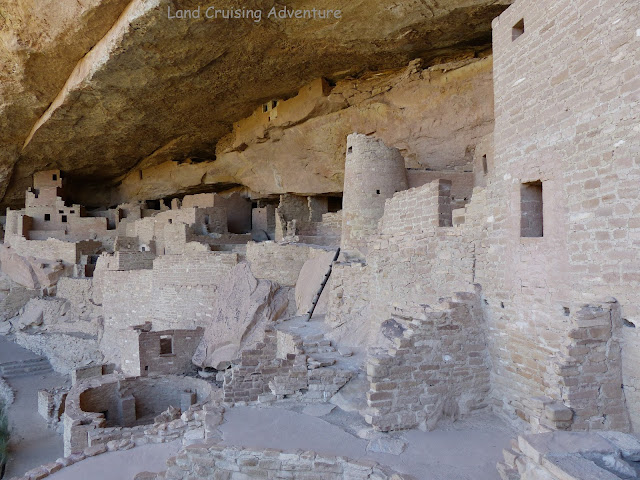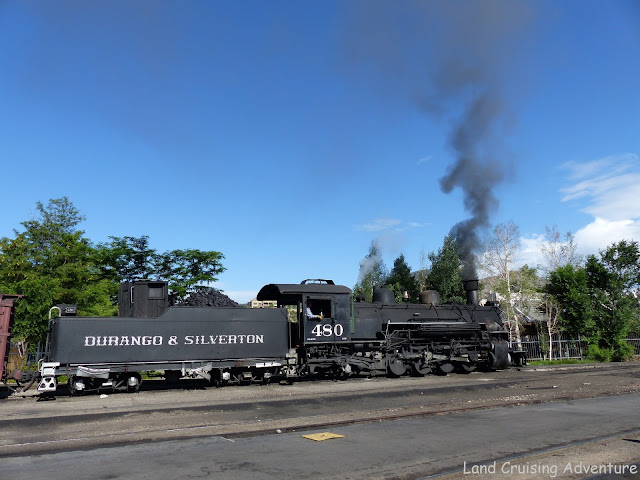Thursday, July 30, 2015
The Galloping Goose
As I was driving down the main street of Dolores, Colorado, I noticed the vehicle shown in the photo above. I decided I had to check it out, to see what it was, since it looked like two separate vehicles attached together.
This turned out to be one of several vehicles that were used starting in the 1930s for about 20 years on the local railroad for both passengers and freight. It was powered by gasoline and ran between Durango and Ridgway. Some of them were built with an open flatbed behind the front area, but this one had been converted to carry passengers. After World War II, the Goose was used for tourism until 1951.
The inside of the front had a few passenger seats, along with the driver seat. The second photo below shows the passenger area in the back, accessible by the rear door.
It's amazing what you'll find in these little towns.
Indian Ceremonial Dances
The town of Cortez, Colorado has an active cultural center, providing programs of local interest. There is a courtyard with an open area for shows, what looks like a pueblo is actually a painting on the flat side of the building.
I attended a program the other evening featuring typical Ute Indian ceremonial dances. It was a family affair, the father was one of the dancers, the son was on the drum and vocals and his two daughters were also dancers.
The son explained the traditional dress of the dancers. The headdress of the father is made of porcupine quills. If he had been doing a certain old traditional dance, the object in his right hand would have contained fresh scalps if the U. S. Government had not outlawed the use of scalps. So, they don't do their scalp dance any longer.
The daughter dressed in the flowered dress has on what they call a breastplate, which was used during conflicts to deflect arrows. Since it's made of buffalo bones, it also makes it hard for someone to grab her around the waist. The footwear is typically beaded moccasins.
The younger daughter did a couple dances, one was a very energetic dance called "Butterfly", which included lots of turns and swirls of her fringed cape.
The older daughter did a couple more sedate dances, but were very traditional. She carried a fan in one hand, and in the other, a Spanish shawl. The Spanish had quite a bit of influence on the early Indian tribes; as a matter of fact, the family performing the dance had a Spanish last name.
Monday, July 27, 2015
Mesa Verde - Long House

Doesn't look like a good day for a hike. About 25 people waited for the Park Ranger to start his briefing on the tour on which he was going to take us. He said he didn't know what the weather was going to do, but if it rained, we would continue on the hike to the ruins. OK, my major concern was my camera, but then I noticed a machine that dispensed doggy poop bags so people can pick up after their pets. They just happened to be camera size.


We climbed some ladders to get to the back of the alcove that housed the ruins. Toward the back, we found a moist, mossy green area which was water seeping into the ruins. This is where the residents got water while they were living there.

The park ranger was full of statistics and we were told that the residents lived there until almost 1300. They ranged in height from 5'2" to 5'5" and the men lived about 35 years. Women weren't so lucky, they lived until about 22 and had an average of about 8 babies - not all of them lived. They worked hard, building homes, farming, making pottery and clothing. They accessed their homes by carving toe and hand holds in the cliff walls to get up to the mesa. Everything brought back to their homes was carried on their backs down the face of the cliff.
Thursday, July 23, 2015
Cliff Palace at Mesa Verde National Park, Colorado
These were built around 1200 using local sandstone, a mix of mud and water between the blocks and local wood.
Evidence shows that they traded with neighbors and people from other villages. Seashells from the Pacific has been found here, as well as items from what is now New Mexico and other places.
These residents farmed corn, squash and beans, as well as hunting deer and small mammals.
The exit from this little community was fun - steps carved in a rock canyon, with 3 ladders to make it to the top, all shown in the photos below.
Wednesday, July 22, 2015
Snowslide Campground, San Juan National Forest - Colorado
Plus, there's a little stream that goes by the campground not too far from the sites. If you like the sound of water running over rocks, this is for you.
When you explore the area, you'll find lots of things, some you don't even have to look for - they'll find you. This little guy was on my neighbor's table one morning after I saw him running around to see what kind of trouble he could get into.

It's a scenic road to the campground, just off a main road headed west from Durango. This old building was picturesque.
If you explore up the road a mile or so, you can find waterfalls and other campgrounds that do not have a fee, but they are not as nice as this one - they're more rustic. Read "roads that are rutted and no picnic tables".
The entire area has lots of wildflowers that were blooming, and some nice hiking trails.
My area had lots of hummingbirds buzzing around. They would fly by your head within inches.
Monday, July 20, 2015
Silverton, Colorado

I arrived in Silverton on the Durango-Silverton Railway. The layover was 2 hours so everyone could explore and have lunch during that time.
I decided to find a place to get a quick sandwich and then wander through the town to take pictures. The buildings are historic and some of the main streets are hard-packed dirt. Unfortunately, there is so much to see, it's not possible to see it all just two hours, especially when you stop for ice cream after lunch! The restaurant shown below was a saloon and bordello back in the early 1900s.
It's obviously very tourist-oriented, with numerous restaurants within a few blocks, as well as ice cream shops and gift shops. It would be a fun place to spend more time.
Durango-Silverton Narrow Gauge Railway - Colorado
If you like to take scenic train trips - don't miss this one. The scenery was spectacular. You can take the train round trip or take the first leg and come back to Durango on a bus. I didn't realize you could do just one way, but if you do, be sure you get on the right side of the train. I think it was the most scenic.
The locomotive uses coal as fuel, so you'll get some smoke and dust from the engine. The trip north gains about 3000 feet in elevation, so there are multiple stops along the way to take on water. At one point, they do a "blow down", to release extra steam that builds up. The photo below shows the steam coming out of the engine in a cloud.
Along the way, we were able to see an elk in a field, horses, farm land and some old railroad cars off to the side.
We went past a serene lake surrounded with pine trees and then started following the river.
The river scenery was spectacular and went through a steep gorge in one area.
There was mostly white water from the current and rocks in the river. In one area, we saw some kayakers that were going down the river. They were waiting in a quiet spot, having gone through one white-water area into another that included a drop that looked to be at least 5-6' into more white water. I'm sure they were getting splashed along the way - and that water is cold!
There were some scenic bridges and foot bridges along the way.
There are coach cars, where you'd be seated in an enclosed car. I opted for the gondola car, there are seats facing the outside and the sides are open from about the waist up. That way, I could take lots of photos. Below are more scenes from the trip - I just tried to pick out the highlights, the ride was bumpy and noisy, but well worth it.
Subscribe to:
Comments (Atom)















































